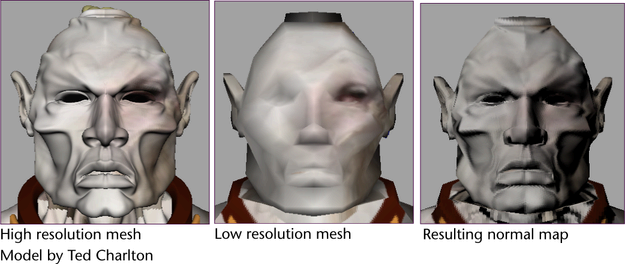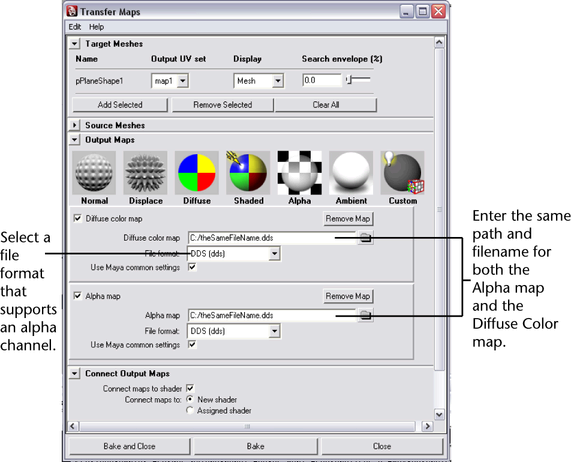Show in Contents

Add to Favorites

Home: Autodesk Maya Online Help

Convert a texture or shading network to a File Texture

Map and position textures

Creating normal maps for use with hardware shaders

Create texture maps with
the Transfer Maps editor
Use
the Transfer Maps editor to create
various types of texture maps. For more information, see
Transfer Maps.
Note
- All Transfer Maps editor
target objects must have clean, non-overlapping UVs.
- NURBS and Subdivision Surfaces are not
supported as source or target meshes. The Transfer Maps editor
can only generate texture maps for polygonal geometry.
- By default, if multiple target objects
are loaded in the Transfer Maps editor, then
a single map is generated for all the targets. However, if you want to
create separate maps for each of your target objects, then you need
to perform the Transfer Maps bake operation
for each target separately.
- You can use display layers or quick select
sets to separate and keep track of your source and target meshes.
- You can use file referencing to bring
high resolution geometry into your scene to be used as source meshes.
For a description of
the Transfer Maps editor options,
see
Lighting/Shading > Transfer Maps.
To create a map of one object’s mesh
attributes and then bake that map onto another object
- Select
Lighting/Shading > Transfer Maps.
The Transfer
Maps window appears.
- In the scene view, select the object
you want as your target. This is the object to
which you want to bake the texture map.
- In the Target Meshes section
of the Transfer Maps editor, click
the Add Selected button.
The object you selected
in the scene view is now the current target for your object transfer
map operation.
- In the scene view, select the object
that you want as your source. This is the object that
has the mesh attributes for which you want to create a texture map.
- In the Source Meshes section
of the Transfer Maps editor, click Add Selected.
The object you selected
in the scene view is now the source mesh for your transfer map operation.
By default, all the unselected meshes in your scene are loaded as
the source meshes.
TipA shortcut to this
procedure is to first select the object that you want as your target
and then select
Lighting/Shading > Transfer Maps.
This way, the object that you selected is automatically listed in
the
Target Meshes section of the
Transfer
Maps editor. All other unselected meshes in your scene
are also automatically loaded as the source meshes.
- From the list of icons, select the types
of output map you want to generate when
you create your texture map and click on the appropriate icon.
See
Output maps.
- Set the output options for each of your
texture maps.
If you plan to create
several maps with the same width and height, you can reuse your
settings by entering them in the
Maya Common Output section
(or mental ray Common Output section)
of the Transfer Maps window.
Otherwise, if you uncheck
the Use Maya common settings option
(or Use mental ray common settings option)
for your texture map, the Map width and Map
height attributes appear in the texture map section that
you are currently working on.
See
Maya Common Output.
- Select one of the following:
- Click Bake and Close if
you want to generate the texture maps and then close the Transfer
Maps editor.
- Click Bake to generate
a texture map and leave the Transfer Maps window open.
- Click Close to
disregard any changes to the Transfer Maps editor
settings.
To create a normal map using the Transfer
Maps editor’s default settings
- Load your source and target meshes into
a new Maya scene.
- Make sure that your source and target
meshes are positioned on top of each other in the scene view.
- Select your target mesh in the scene
view.
- Select
Lighting/Shading > Transfer Maps.
The mesh you selected
is automatically loaded as a Target and all other meshes in your
scene are loaded as Sources.
- In the Output Maps section,
click on Normal from the list of icons
to create a Normal map.
- Set the following attributes in the Normal map
section:
- File name (Normal map field)
This determines the name
of the texture map file as well as where the map will be saved.
This determines the file
format of the normal map you generate.
NoteIf you want to render
your normal map in mental ray for Maya, you must save the normal
map as one of the supported formats: EXR, Maya IFF, JPEG, MI, PNG,
YUV, RLA, SGI, PIC, TIM, TGA, and BMP. You must also turn on the
Maya
derivatives option in the
Render Settings: mental ray tabs,
Options tab,
Translation section,
Performance sub-section.
For more information, see
Render Settings: mental ray tabs in
the
Rendering guide.
Select Tangent
Space.
- Check the Use Maya common settings option
so that you can share and reuse your settings when you create more
than one map with the same width and height.
- Scroll to the Maya Common Output section
and expand the section to set your common map attributes. Set the
following options:
This specifies the resolution
for the texture map.
NoteThe Maya scene view
only supports tangent space maps and they are only visible in the
scene view when in High Quality Rendering mode.
- Select a medium Sampling
Quality.
- Select World Space in Transfer
in.
- Keep the rest of the options at their
default settings.
- Scroll to the Connect Output Maps section
to specify how the texture map you are going to create will be linked
to the target mesh. To view the results of the texture map within
Maya, enable Connect maps to: New shader /Connect
maps to: Assigned shader.
- Bake the normal map.
Tip
- You can use display layers or quick select
sets to separate and keep track of your source and target meshes.
- You can use file referencing to bring
high resolution geometry into your scene to be used as source meshes.
To
create a left-handed tangent space normal map
- In order to create a left-handed tangent
space normal map, you must do the following:
- Open the Attribute Editor for
the target meshes’ shape node.
- Expand the Tangent Space section
and select Left Handed under Coordinate
System.
For more information
regarding the left handed tangent space, see
Tangent Space of
the Polygonal Modeling guide.
Advanced normal map generation
To create a custom search envelope
- Select
Lighting/Shading > Transfer Maps.
The Transfer
Maps editor appears in the scene view.
- In your scene view, select the polygonal
mesh that you want to define as your custom search envelope.
- In the Target Meshes section,
click Add Selected.
The selected mesh is
loaded into the Transfer Maps editor as a
target mesh.
-
 -click
on the mesh’s name In the Target Meshes section
and select Use Selection as Envelope from
the context-sensitive menu that appears.
-click
on the mesh’s name In the Target Meshes section
and select Use Selection as Envelope from
the context-sensitive menu that appears.
The polygon mesh you
selected is now the search envelope for your Transfer
Maps operation.
To create a texture map with an alpha
channel
- Transfer maps allow you to pack any scalar
output (for example, alpha or displacement) into the alpha channel
of the texture map being used for a vector output (for example,
color or normal). Therefore, you can create, for example, a color
map with alpha, or a normal map with displacement, or a color map
with displacement, and so forth.
- Select a file format that supports an
alpha channel (for example, .dds, .exr, .tif).
- Enter the same path and file name into
the two output you want to combine into a single texture map. The
path and file names are case sensitive.
- Bake the map.
NoteIf the Connect
maps to shader option is enabled, Maya attempts to connect
the combined map to the shader. However, many of the combinations
that are generated using this method require a custom (hardware) shader
for correct display in the scene view.

 -click
on the mesh’s name In the Target Meshes section
and select Use Selection as Envelope from
the context-sensitive menu that appears.
-click
on the mesh’s name In the Target Meshes section
and select Use Selection as Envelope from
the context-sensitive menu that appears.
